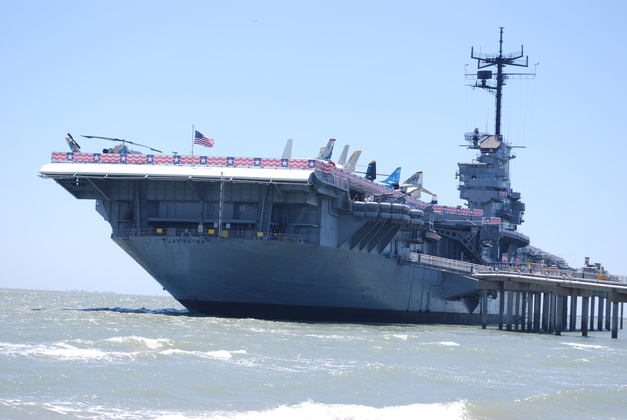
|
|
USS Lexington
|
11/15/12: We went back to the Lexington and took a few more shots.
According to the book "Carrier Lexington" by Hugh Power, the Lex has two sets of boiler rooms and engine rooms, for a total of 8 boilers and 8 turbines.
The boiler room/engine room pairs were arranged within the hull for maximum resistance to battle damage.
The turbines are cross compound turbines, that is, a high pressure turbine followed by a low pressure turbine on separate shafts connected by locked train reduction gears to each other and a single propeller shaft.
One other note about the engines and battle damage, the low pressure turbines can be used, by themselfs, to run the Lexington in reverse at 20 knots so the forward deck may be used to recover aircraft if the aft end is damaged.
All these pics are shot in hi-rez, if anyone wants to see them email me at  and I'll make them available.
and I'll make them available.
book: "Carrier Lexington" by Hugh Power at Google
USS LEXINGTON's Vital Statistics
Crew: 1,550 Men and Women
Length of the Flight Deck: 910 Feet
Height (Water Line to Flight Deck): 52 Feet
Maximum Width: 196 Feet
Draft (Keel to Water Line): 30 Feet
Displacement: 42,000 Tons
Speed: 30+ Knots
Range at Maximum Speed: 4,131 Miles
Engines: 4 Westinghouse Steam Turbines Developing 150,000 Horsepower
Screws/Propellers: Four, Sixteen Feet in Diameter
Decks: Sixteen from Top of Pilot House to Double Bottom
Steam: 600 PSI, 850 Degrees
Boilers: 8 Babcock & Wilcox (M-Type 619 PSI)
Generators: Four - 1,250 Kilowatts and Two - 1,000 Kilowatt Emergency Generators
Fresh Water Production: 180,000 Gallons per Day
Fuel Storage: Ship's Fuel-1,500,000 Gallons. Aviation Fuel - 440,000 Gallons
Medical Facilities: Surgical Facilities with 20 bed capacity. 2 Doctors/14 Corpsmen
Dental Facilities: 2 Dentists/7 Technicians
Library: Over 40,000 Books
Catapults: Two Steam-Powered C-ll Catapults
Catapult Launching Area: 211 Feet
Flight Deck Landing Area: 90,000 Square Feet
Hangar Bays: Three, Totaling Over 40,000 Square Feet
Anchors: 15 Tons, 50 Pounds
Food Service: Crew daily consumed 660 pounds of meat, 164 gallons of milk and 97 dozen eggs.

|
Our first "close up look" at the Lexington (her aft end from the starboard quarter).
Click the pic for hi-rez.
One of the quad 40mm mounts can be seen just below the flight deck at the rear, it has diagonal supports up from the side of the ship.
This is the after starboard mount.
|

|
The USS Lexington's battles.
The Lexington is the United States Longest serving carrier and her record shows it.
|
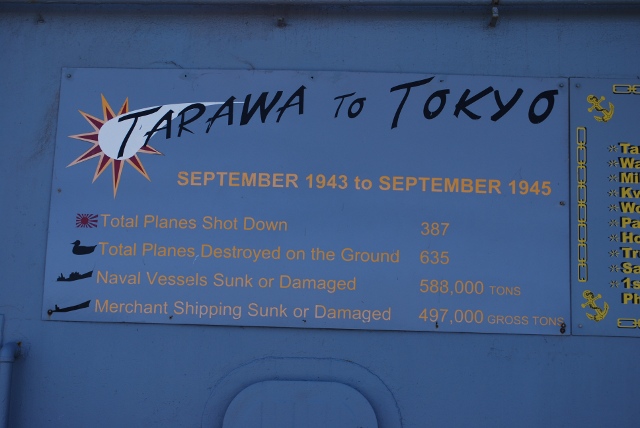
|
The Lexingon's statistics.
|
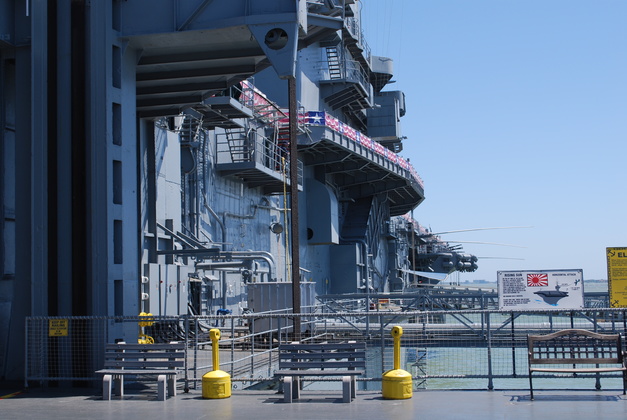
|
Looking forward from the starboard elevator.
What are the giant "curb feelers" sticking out near the bow?
They are on each side of the ship.
|
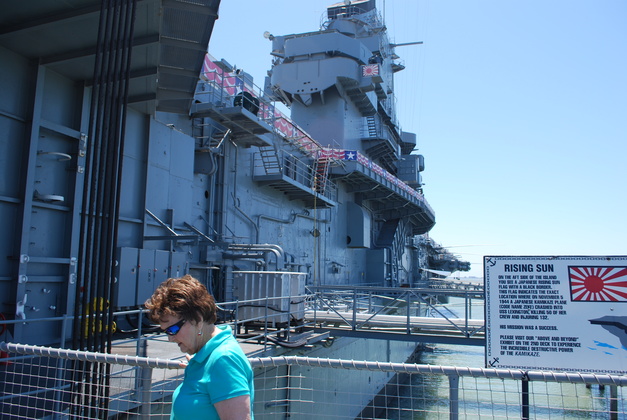
|
Note the Japaneze flag up high on the bridge island, thats where a kamakazi struck the ship.
Click the pic to see a hi-rez image, you can zoom in and read the sign, and get another look at the "curb feelers".
|
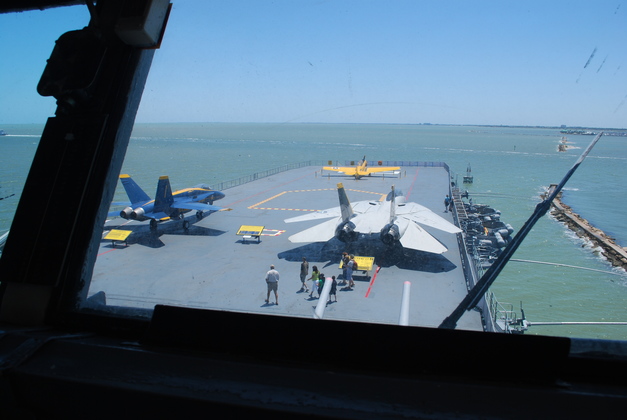
|
Looking forward from the bridge, note the "curb feelers" again, on the right.
You can see a F-14 Tomcat on the starboard side (right), and an F-18 on the port side (left).
|
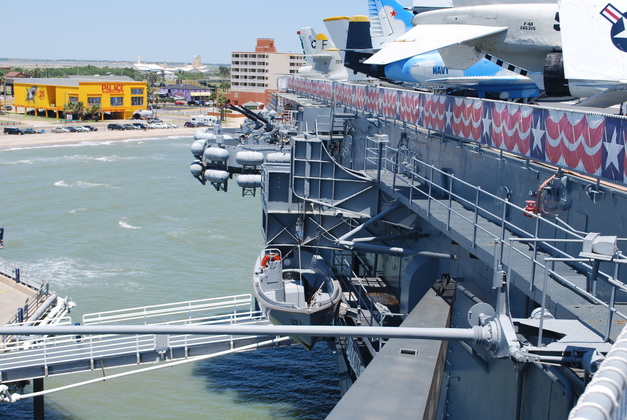
|
Close up of a "curb feeler", just aft of the bridge on the starbord side.
You can see a quad 40mm mount near the aft end.
|
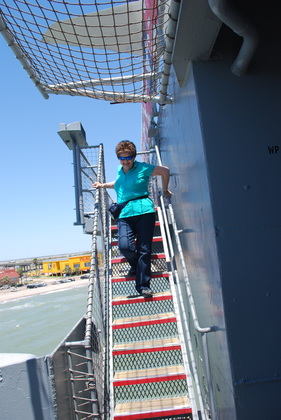
|
Betty walking down to the quad 40mm cannon mounts.
Note her smile, on our trip she kept finding
larger and larger caliber firearms that she really liked.
Also check out her shooting iron page.
|
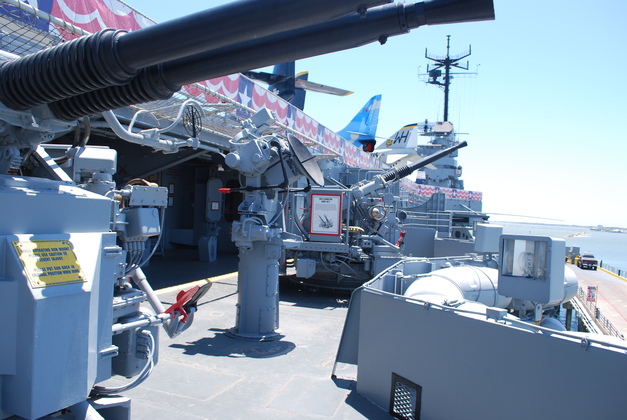
|
The quad 40mm mount.
There appear to have been 4 of these mounts, 2 on each side of the ship, right under the flight deck.
Thats 16 40mm cannon (rifles), plus the two 5" mounts on the flight deck.
|
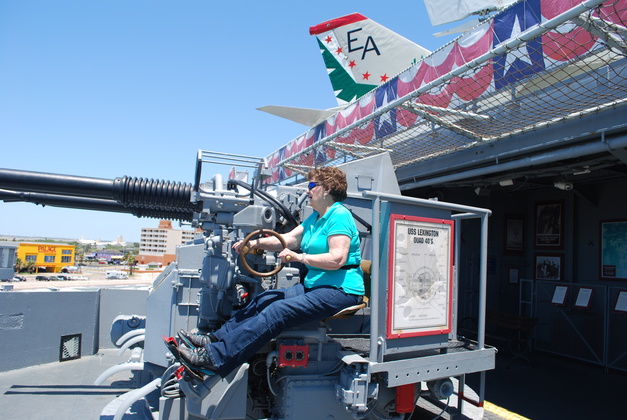
|
Betty aiming a pair of 40mm cannon.
|

|
Betty aims higher.
|
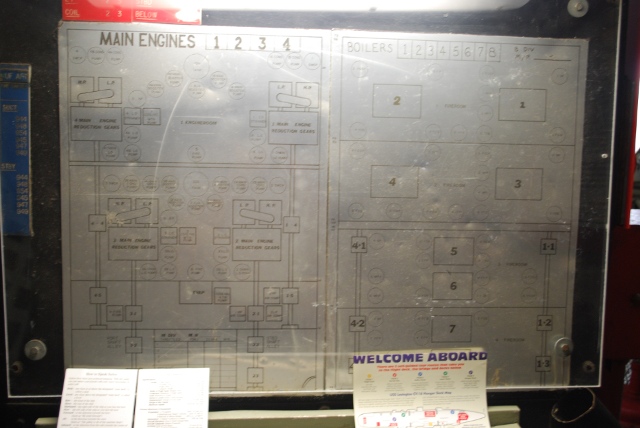
|
The diagram in the engine room.
Click on the pic for hi-rez.
The ship has two engine room/boiler room pairs, each with 4 boilers, and two compound turbines.
|
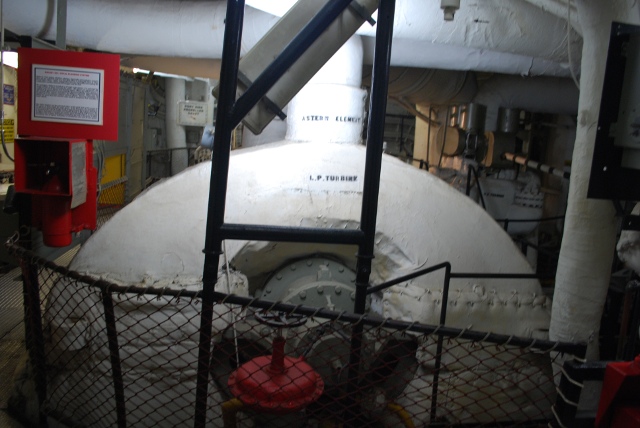
|
One of the low pressure turbines, this one and it's smaller high pressure teammate put out 37,500 Horse Power.
There are two pairs in this room for a toatal of 75,000 HP, and another engine room with two pairs of turbines for a total 150,000 Horse Power.
Click on the pic for hi-rez.
|
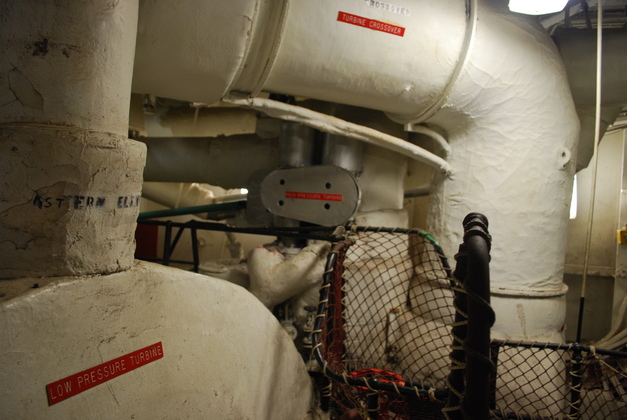
|
Low pressure turbine in the foreground, the crossover, and the top of the high pressure turbine.
|
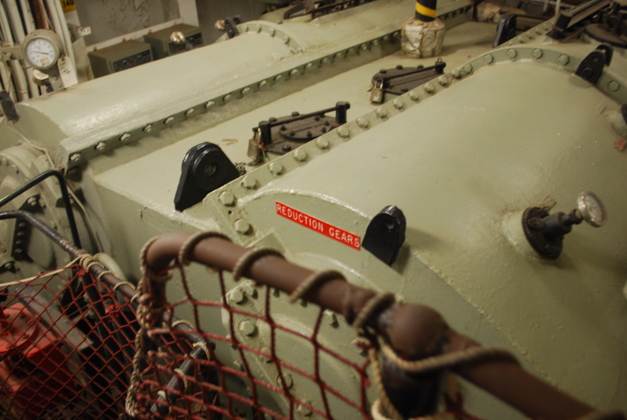
|
Front of one of the locked train reduction gear boxes, the low pressure shaft is in the fore ground the hi pressure shaft behind it.
|
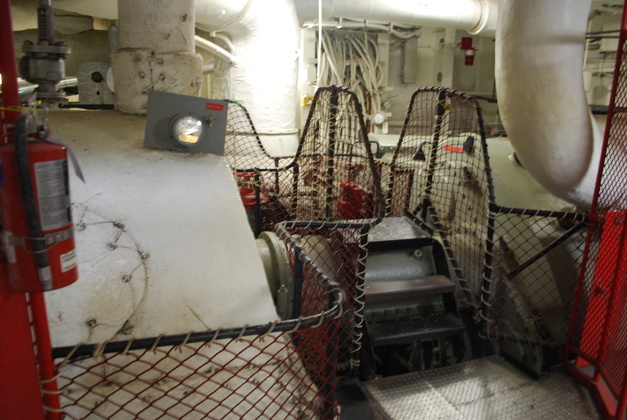
|
Pull back from the pic above, the low pressure turbine is on the left, the crossover above, the shaft from the low pressure turbine to the reduction gear in the middle, and the reduction gear boxes on the right.
These are cross compound turbines, they are on two different parallel shafts, connected to each other through a reduction gear box (see above pics).
The highest pressure steam is fed to the high pressure turbine, on the far side, then routed through the crossover to the low pressure turbine, then to a condenser so the water may be reused.
|
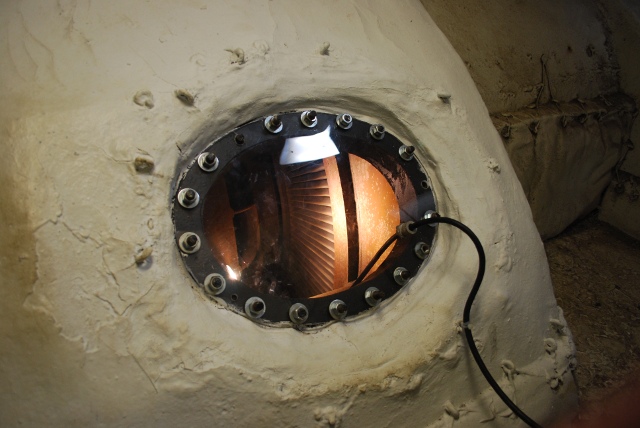
|
View through the inspection plate into a turbine.
|
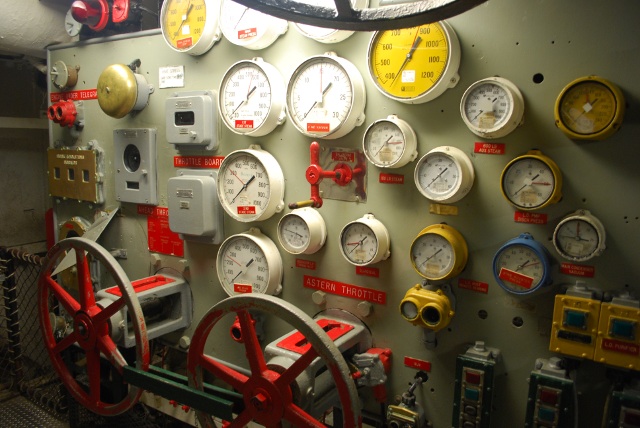
|
Engine control panel from midship.
Click pic for hi-rez.
|
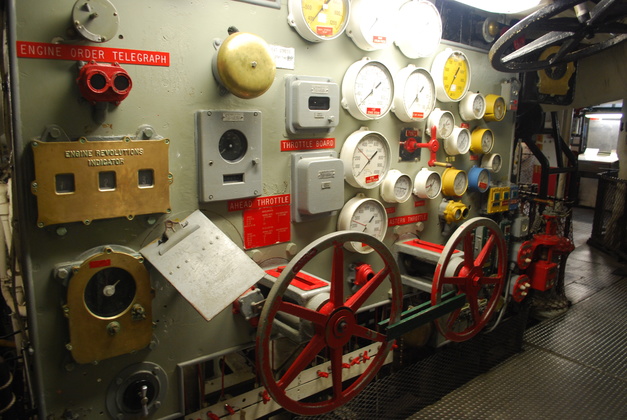
|
Engine contorl panel from outboard.
Click pic for hi-rez.
|
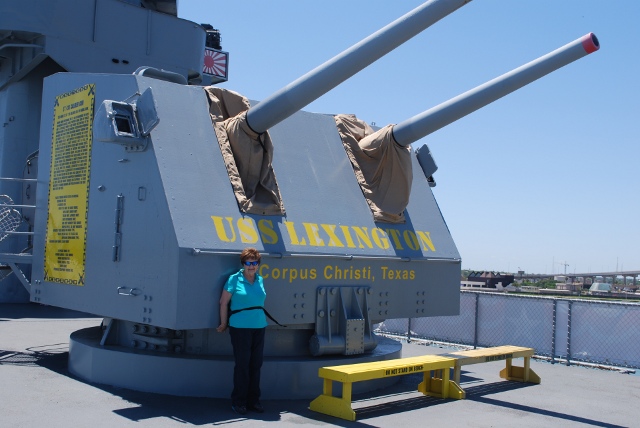
|
Betty finds an even larger caliber shooting iron.
This is a 5 inch mount on the flight deck just behind the bridge island.
|
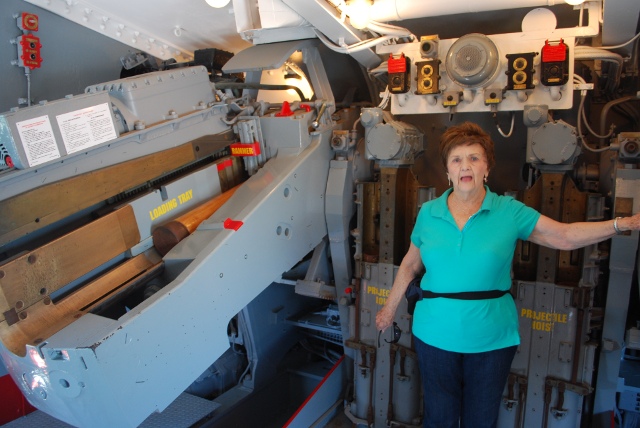
|
One of the guns inside the 5 inch mount.
These 5 inch cannon still use an actual cartridge instead of a separate projectile, and propellant bags.
You can see the loading tray with a dummy 5" cartridge, the projectile hoist behind Betty, and the firing controls above her.
Her left hand is on the rightmost cannon's firing tray.
It appears the men in this mount would take a cartridge from the hoist, place it in the loading tray, use the rammer to force it into the cannon's breach, then fire.
The empty cartridge would be ejected then one of the men would make sure it went down and ont the deck below and outside the mount.
|
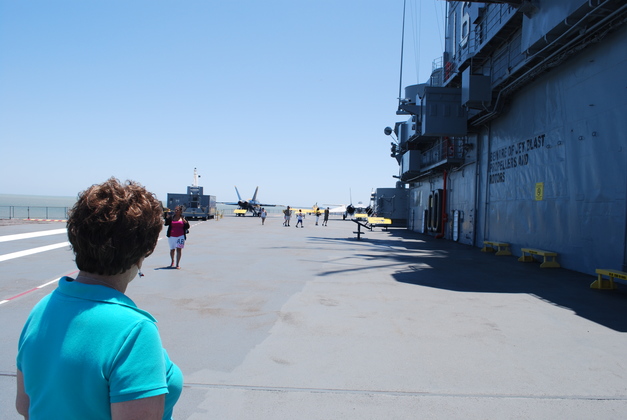
|
Betty looking toward the front of the flight deck from appoximately the center of the ship.
This might give you a small idea of how large the flight deck and the ship is.
|
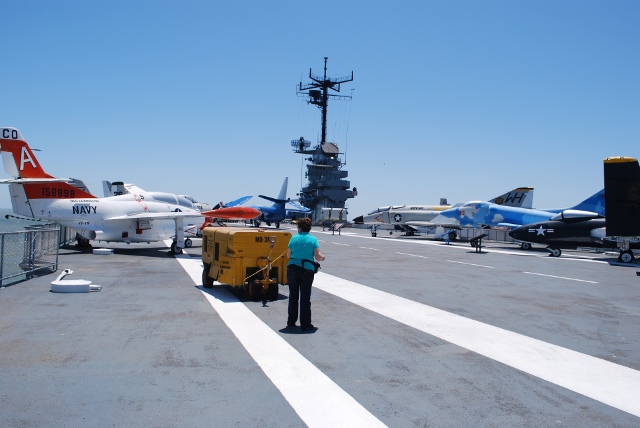
|
Again looking forward, but from near the aft end, you can see just a few of the actual air craft on display on the flight deck.
|
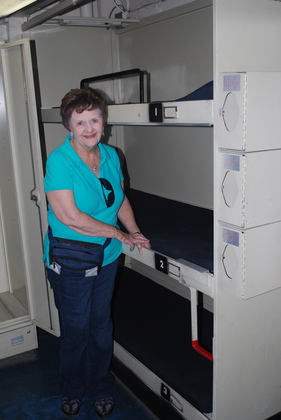
|
The Focs'l, crew's compartment.
|
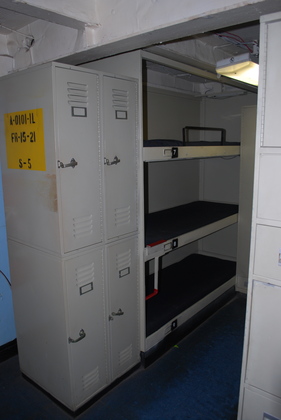
|
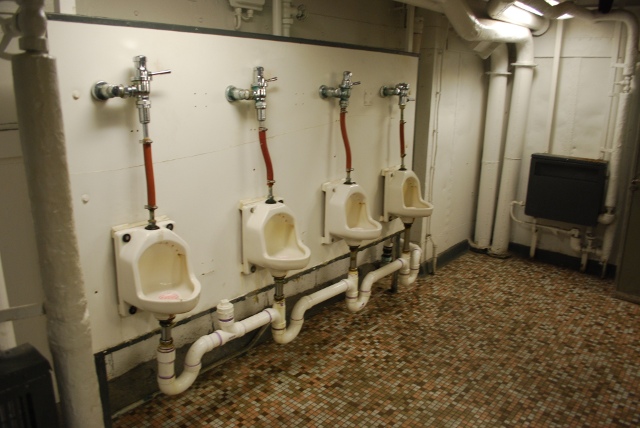
|
One of the heads.
I noticed the urinals were very small and higher than normal land based devices.
|
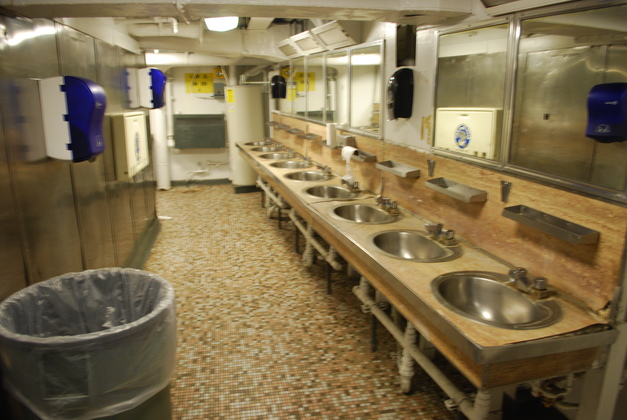
|
The wash basins in the head.
|
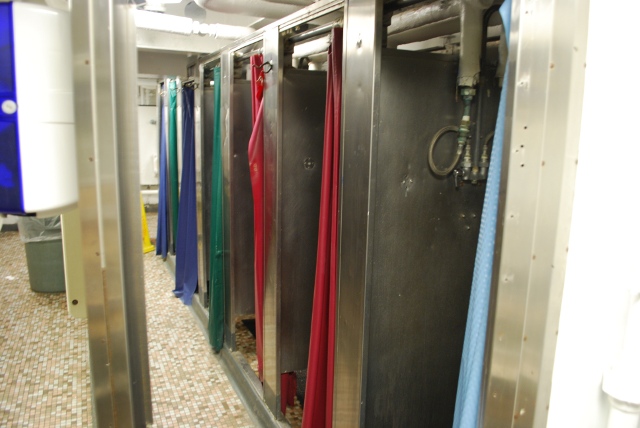
|
Showers in the head.
|
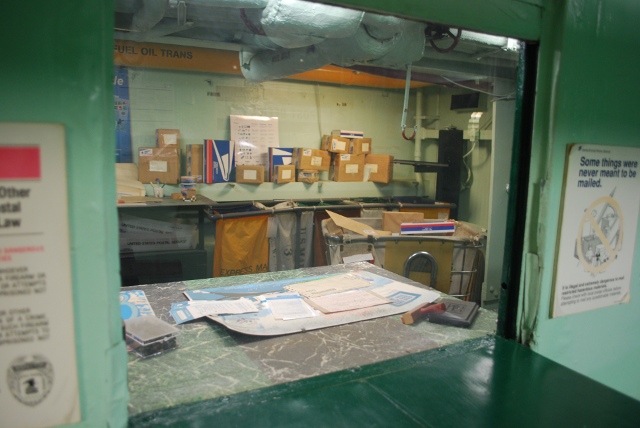
|
The mail room, a United States Post Office.
From the signs, US Navy ships delivered US Mail all over the world.
|
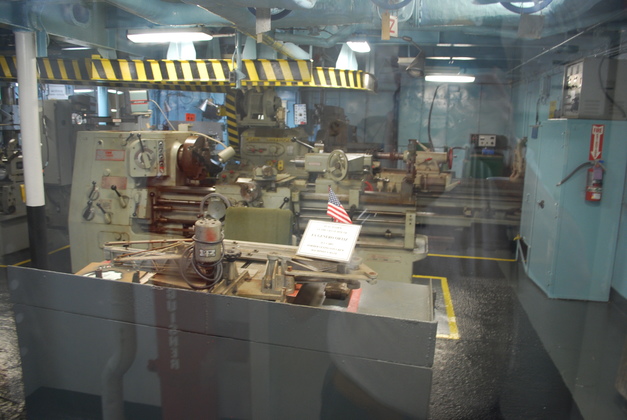
|
The machine shop, where parts of the ship were repaired.
Note the large lathes
|

|
Another view of the machine shop, large end mill, and more lathes.
|
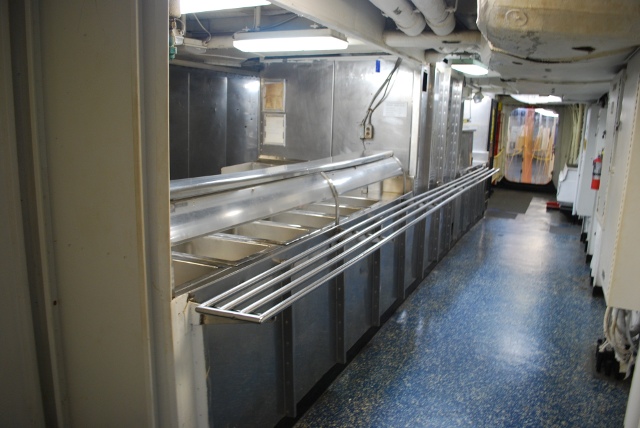
|
Crew's mess, whre food was prepared and served.
There is a larger open area next to this, I assume where the crew acutally ate.
|
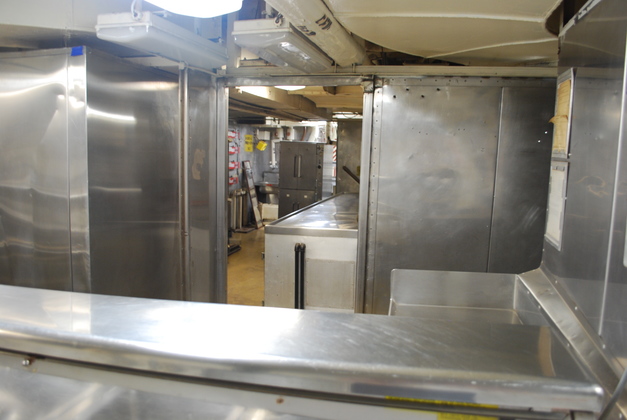
|
Kitchen behind crew's mess.
|
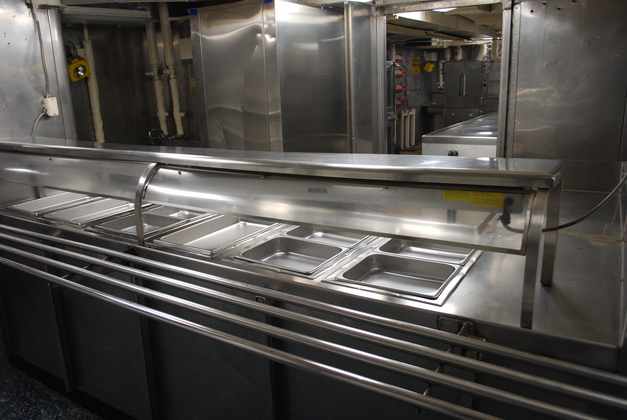
|
Another shot of the serving line, showing some of the prep area behind.
|
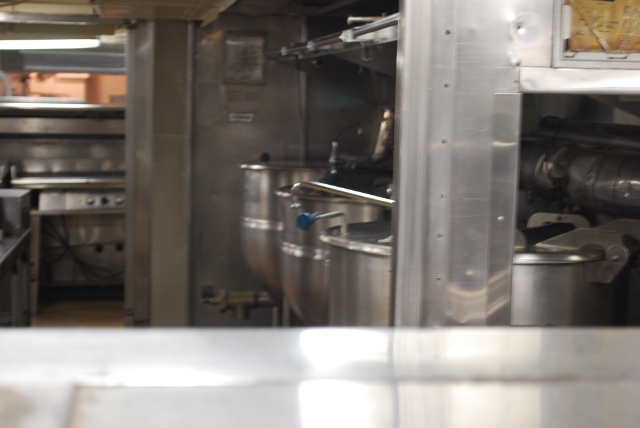
|
Some of the steam cook kettles in the prep area.
|

|
Stainless steel trays ready for to serve.
|
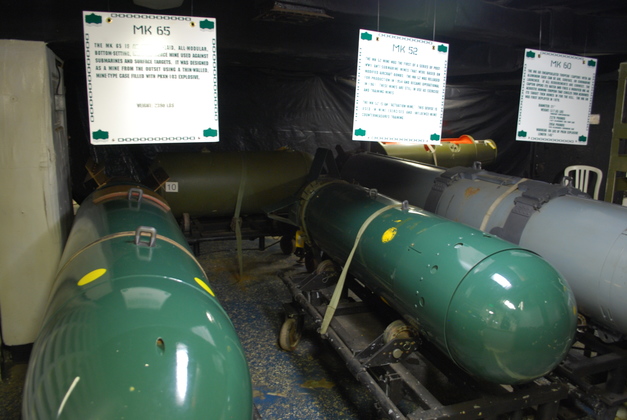
|
Naturally the Lexington carried all kinds of bombs for the aircraft.
|
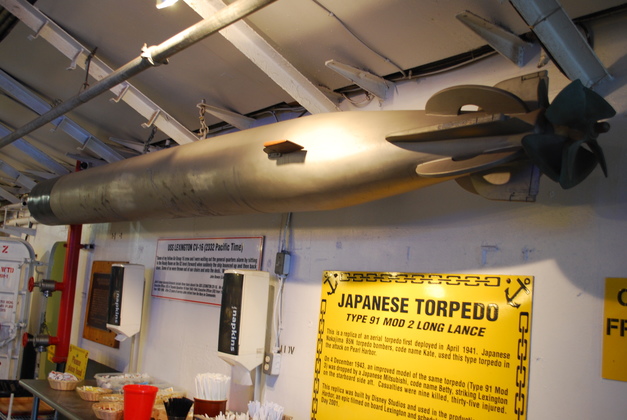
|
And even a Japanese "Long Lance" torpedo on display.
The "Long Lance" could be fired from a submarine, surface vessle, or dropped from an aircraft.
This one is a replica built by Disney for the movie "Perl Harbor".
It is like the one that struck the Lexington in April 1941.
The "Long Lance" had a much longer range than standard Japanese torpedoes so the US Navy ships had to stay a lot further from Japanese destroyers etc. carrying these.
When these were first intorduced they caused a lot of problems among US Navy surface craft.
|
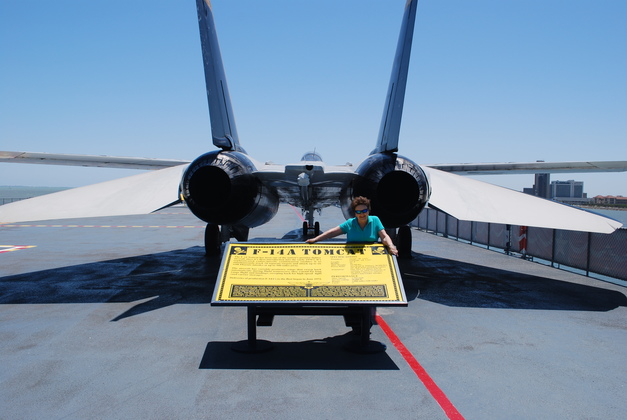
|
An F14-Tomcat on the deck.
|
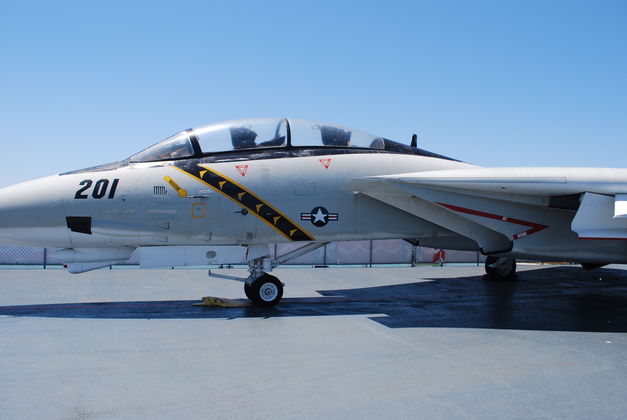
|
Another shot of the F14.
|
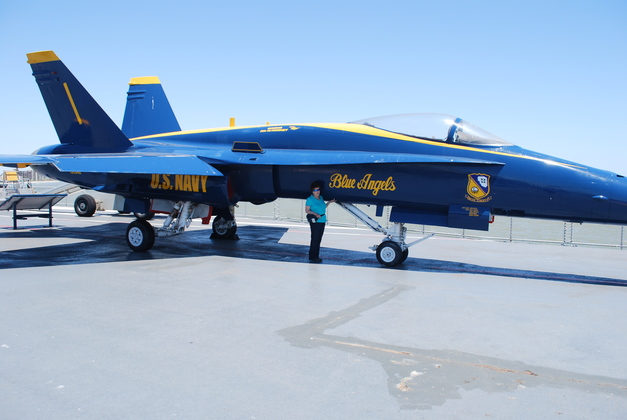
|
Betty and one of the Blue Angel's FA/18 Hornets.
|
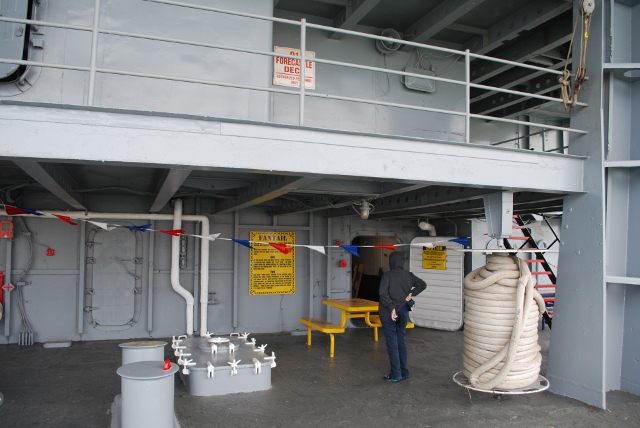
|
Pic on the fan tail, or "Poop Deck".
Notice the spool of hawser for tying the ship up, there are two on the fan tail.
One of the men working on the Lex. told me it didn't look like this when the ship was in service, he said this area was covered with guns (probably anti aircraft like the 40mms).
|
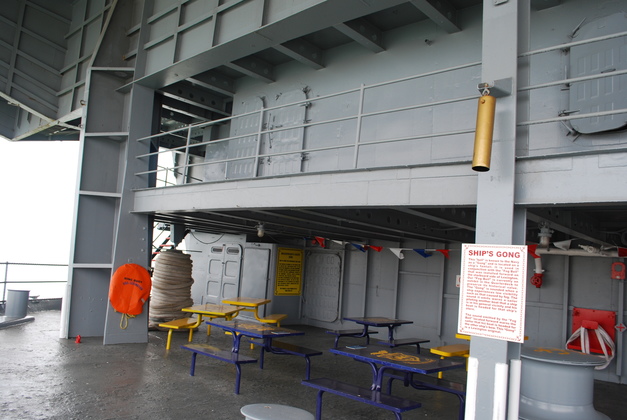
|
Another shot of the fan tail.
|
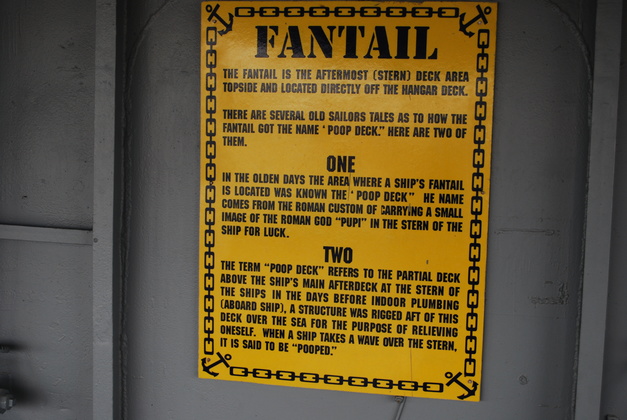
|
Explanation of the term "Poop Deck".
|
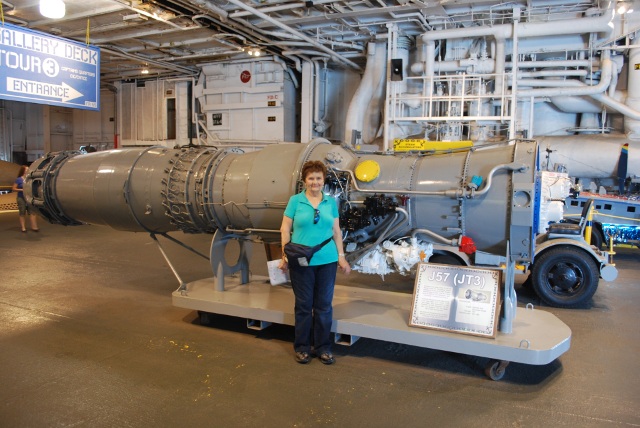
|
Betty and a J57 jet engine, 13,000 Lbs of thrust (19,600 HP with the afterburner).
Used on: U-2 reconnaissance plane, prototype of Republic's F-105 Thunderchief, F8U-1, F-100 Super Sabre, Boeing 707 (no afterburner), F-102 Delta Dart, DC-8, B-52, and KC-135.
|
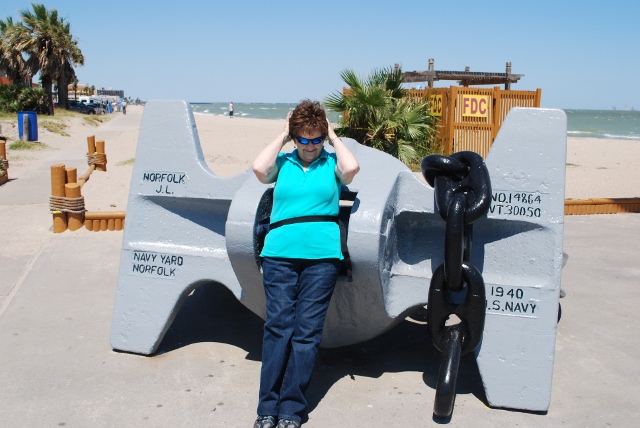
|
Betty and one of the Lexington's anchors weighing 30,050 Lbs.
|
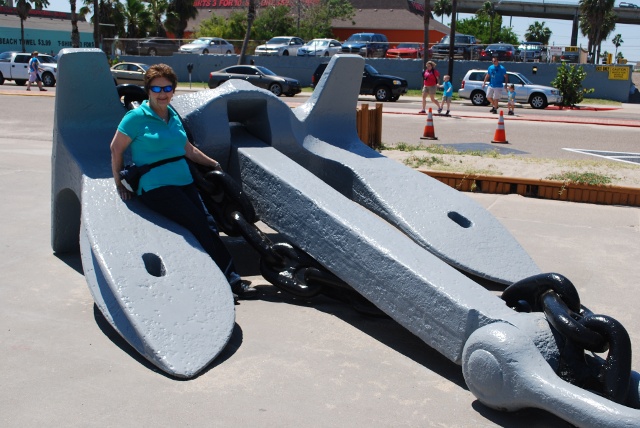
|
The anchor from the other side.
|
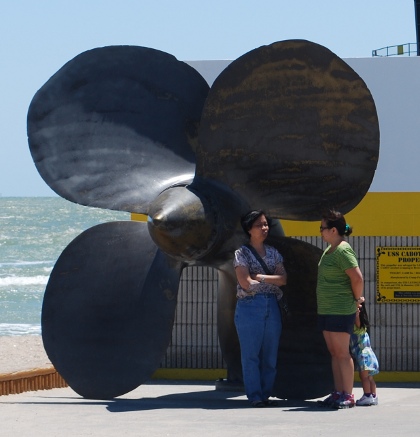
|
USS Cabot's (CVL-28) propeller, 11 feet in diameter, weighs 13,800 lbs.
One of the Lexingon's propellers is 16 ft. in diameter and weighs 16,000 lbs.
|


 and I'll make them available.
and I'll make them available.











































